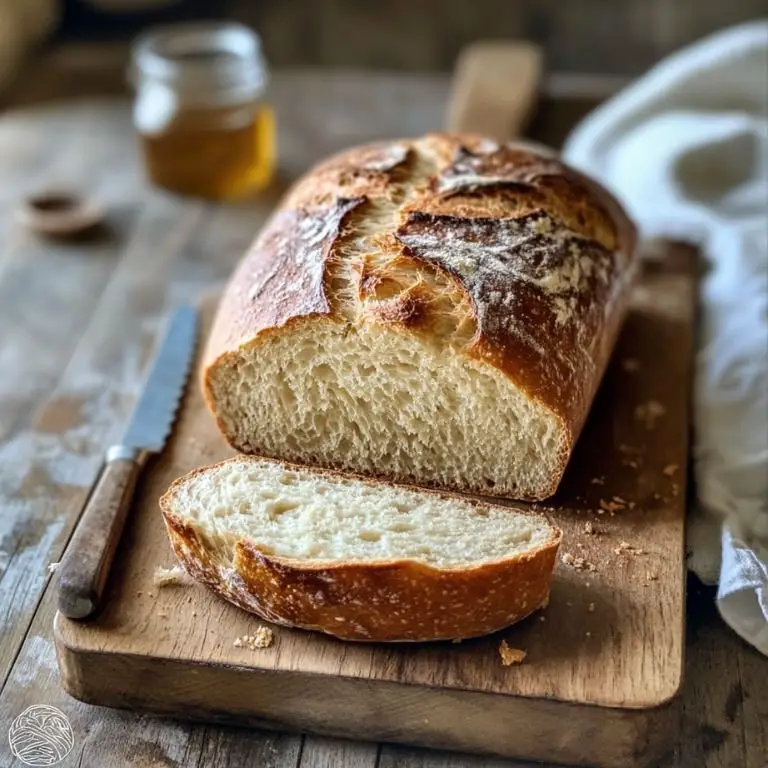If you’re craving a loaf with old-world charm, deep flavor, and a hearty bite, this sourdough rye bread loaf is your new go-to. Made with a mix of rye and bread flour, this loaf balances tangy, earthy notes with a soft, chewy texture—perfect for sandwiches, toast, or even sourdough breakfast recipes like egg-in-a-hole or savory French toast. It’s ideal for anyone looking to explore beyond basic white loaves, yet still accessible enough for those dipping their toes into homemade sourdough bread recipes. Whether you’re using sourdough starter from scratch or repurposing discard, this is the kind of bake that makes you feel like a seasoned home baker.
Sourdough Rye Bread Loaf
Prep Time 25 minutes mins
Cook Time 40 minutes mins
Fermentation 7 hours hrs 55 minutes mins
Total Time 9 hours hrs
Course Side Dish
Cuisine American, European
Servings 1 loaf (10–12 hearty slices)
Loaf pan (9x5 inch) If you’re focused on sourdough bread in a loaf pan for easy slicing and storage, this is essential.
Mixing bowls At least one large enough for rising dough.
Bench scraper To help with sticky rye dough.
Kitchen scale Accuracy is important, especially with rye which absorbs water differently than wheat.
Towel or plastic wrap For covering the dough during fermentation.
- 300 g 2 ½ cups bread flour
- 200 g 1 ½ cups rye flour – Light or medium rye both work well.
- 100 g 1/2 cup sourdough starter – Active and bubbly; or use it as a sourdough discard loaf with a bit more rise time.
- 350 ml 1 ½ cups warm water
- 12 g 2 ½ tsp salt
- 1 tbsp honey or molasses – Optional but adds a gentle sweetness that balances the rye.
- 2 tbsp olive oil or softened butter – Makes it more tender especially helpful if you’re aiming for a soft sourdough sandwich bread feel.
Combine Ingredients
Mix the flours, water, and sourdough starter in a bowl until a rough dough forms. Let rest for 30 minutes (autolyse).
Add Salt, Honey, and Oil
After resting, add salt, honey/molasses, and oil. Knead until incorporated. The dough will be sticky because of the rye, so knead gently and don’t overwork it.
Bulk Fermentation
Cover the bowl and let the dough rise at room temperature for 5–6 hours. You can do a few stretch-and-folds early on to help build structure, especially since rye flour lacks strong gluten development.
Shape the Loaf
Turn the dough onto a floured surface, shape it into a log, and transfer it into a greased loaf pan. This step is key if you want a reliable sourdough sandwich bread recipe without fussing with proofing baskets.
Final Proof
Let the shaped dough rise for another 1.5–2 hours, covered. It should dome just above the edge of the pan.
Bake
Preheat oven to 375°F (190°C). Bake the loaf for 40 minutes or until dark golden brown. For a crisper crust, you can mist the oven at the start of baking.
Cool and Slice
Let the loaf cool for at least an hour before slicing—this helps finish setting the crumb and makes slicing cleaner.
Pairings
This sourdough rye loaf is made for bold flavors. It’s perfect with smoked salmon and cream cheese, sharp cheddar and mustard, or as the base for an open-faced Reuben. For sourdough breakfast recipes, try topping a toasted slice with a fried egg, sautéed greens, and hot sauce. It also shines alongside soups, stews, and anything that begs for a good bread dunk.
Looking for more sourdough bread ideas? Cube leftovers for croutons, slice for hearty sandwiches, or use in a rye-infused bread pudding.
FAQs
1. Is this a sourdough quick bread?
Not exactly—it’s a naturally leavened loaf, so it needs time to ferment. But if you’re looking for quick sourdough discard recipes with flavor and substance, this loaf can work well with discard and an extended proof.
2. Can this be used for sandwiches?
Yes! Despite rye’s dense nature, this makes an easy sourdough sandwich bread that’s sturdy yet soft enough to slice thinly and pile high. It’s not your typical soft sourdough sandwich bread, but it has a satisfying chew that holds up beautifully.
3. What makes this a good choice for beginners?
This is sour dough bread for beginners who are ready to experiment with rye. It skips complex scoring or hydration ratios, and baking it in a loaf pan simplifies shaping.
4. What kind of sourdough starter should I use?
A regular wheat starter works just fine. If you maintain a rye starter, that’s even better. This recipe is forgiving, whether you’re using sourdough starter fresh or discard-style.
5. How does this differ from a classic sourdough bread recipe?
This variation leans rustic with its rye flour, yet stays soft and sliceable—making it one of those easy sourdough bread recipes that feels both traditional and modern.
